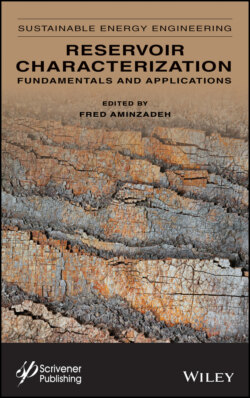Читать книгу Reservoir Characterization - Группа авторов - Страница 50
3.7 Bootstrap Based Tests of Anomaly Type Hypothesis
ОглавлениеThe hypothesis test discussed in this section is the first step in a more definite and automatic determination of anomaly type. It relies on the use of the anomaly indicator defined by Eq. 3.11:
detectedAnomalyPart - is the dataset formed by records identified as anomaly by an AD classifier, φj - anomaly characterization functions on average taking larger values on regular records and smaller values on records within hypothesised anomaly, ηj - positive coefficients, J is the total number of anomaly characterization functions.
Further we use Poisson’s ratio as a single anomaly characterization function and assign a single η1 value 1.
In that case, anomalyIndicator takes the form:
According to Ostander [22], high-porosity, brine-saturated sandstones tend to have high Poisson’s ratios of 0.30 to 0.40, while gas-saturated sandstones may have a Poisson’s ratio as small as 0.1. Data presented by Jain et al. [23] show that Poisson’s ratio for gas-saturated sands is in the range of 0.2-0.25, so that the largest possible value of the anomaly indicator (3.12) in the case of a gas-filled sand anomaly is around 0.8. So the following assumption might be valid for gas-saturated sands with porosity in a wide range of values: If AnomalyIndicator is larger than 0.8, then the anomaly type is not gas-saturated sands. Then the hypothesis H0 for anomaly type with alternative H1 may take the form:
(3.13)
where significance cutoff = 0.8 and significance level α = 0.05.
Hypothesis H0 is rejected if the probability to exceed the significance cutoff is smaller than a predefined significance level. Rejection of hypothesis H0 does not contradict the assumption that the detected anomaly is gas-filled sands. If hypothesis H0 is not rejected, then there is a contradiction between the results of the test and the assumption that the detected anomaly is gas-filled sands.
The anomalyIndicator in Eq. 3.12 is a random variable which value is affected by many random factors. These factors include the noise that distorts records in the training and test sets, the variability of the detectedAnomalyPart, and the non-zero posterior false discovery rate. To test the anomaly type hypothesis and to estimate the p-value we used a bootstrap that generates multiple pairs of training-test sets and, respectively, multiple bootstrap samples of anomalyIndicator. In the experiment presented in this section, the number of bootstrap-generated samples of anomalyIndicator calculated for four AD classifiers was 1000. These samples were used to calculate distributions of the anomaly indicators and to estimate the probability of exceeding the significance cutoff by the anomalyIndicator.
Figure 3.9 Histograms of anomalyIndicator for three types of classifiers. (a)-adaptive aggregated classifier, (b)-distance, (c)-sparsity. Intersection of vertical dashed lines with x-axis - value of significance level
Table 3.3 Percent of values of anomalyIndicator exceeding significance cutoff α (p-value).
| Number of records in the train set | Expected false discovery rate (%) | Percent of values of anomalyIndicator exceeding significance level (p-value) | ||
|---|---|---|---|---|
| Sparsity | Distance | Aggregated | ||
| 25 | 20 | 0.2 | 3.7 | 0.01 |
| 20 | 20 | 2.1 | 16.2 | 0.04 |
| 15 | 20 | 14.5 | 36.4 | 0.1 |
| 12 | 20 | 28.7 | 47.4 | 0.8 |
| 10 | 20 | 42.5 | 47.5 | 1.7 |
| 7 | 20 | 69.2 | 56.5 | 6.7 |
| 5 | 20 | 77.3 | 60.4 | 9.9 |
Figure 3.9 shows three histograms of bootstrap generated values of anomaly indicators for three types of AD classifiers. Vertical dashed lines are drawn at the value of significance cutoff a equal to 0.8. Histograms were calculated for the 20 records training sets. According to Figure 3.9, distribution of the anomaly indicator is the narrowest and is shifted in the direction of small values when an adaptive aggregated classifier is used. Distribution obtained with the distance classifier is characterised by the largest percent of values of an indicator exceeding the significance level a. Generally, the percent of anomalyIndicator samples exceeding the significance cutoff is higher for universal classifiers compared to the aggregated classifier.
More detailed information on results of anomaly type hypothesis test is given in the Table 3.3. It shows p-values for the hypothesis tests for three types of AD classifiers and for multiple sizes of the training set. One can observe that p-values are smaller than significance level for all three classifiers if the training set contains 25 records. With decrease of the size of the training set p-value increases for all three AD classifiers. It becomes larger than 40% for universal classifiers when the size of the training set is 10 records or lower. P-value does not exceed 10% for all sizes of the training sets in the case of aggregated classifier. It remains smaller than the significance level for a sample size of 15 records or larger. For p-values smaller than the significance level, hypothesis H0 is rejected so that statistically significant results of the test are in accordance with suggestions that the detected anomaly is gas-filled sands. Therefore, statistically significant results for tests of anomaly type hypothesis were obtained for sizes of the training set larger than 10 records in the case of the adaptive aggregated classifier, for the size of a training set of 25 in the case of the distance classifier, and for sizes of 20 and 25 records in the case of the sparsity classifier.
